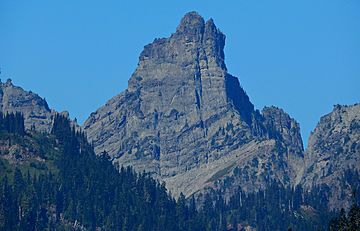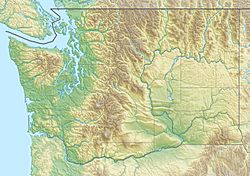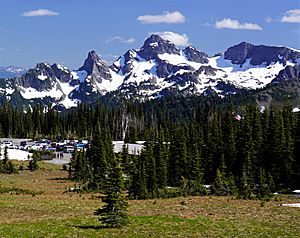Cowlitz Chimneys facts for kids
Quick facts for kids Cowlitz Chimneys |
|
|---|---|

North Cowlitz Chimney seen from State Route 123
|
|
| Highest point | |
| Elevation | 7,605 ft (2,318 m) |
| Prominence | 965 ft (294 m) |
| Isolation | 4.84 mi (7.79 km) |
| Parent peak | Little Tahoma Peak (11,138 ft) |
| Geography | |
| Location | Mount Rainier National Park Pierce County, Washington, U.S. |
| Parent range | Cascades |
| Topo map | USGS Chinook Pass |
| Type of rock | Rhyolite |
| Climbing | |
| First ascent | 1915 by The Mountaineers |
| Easiest route | Scrambling class 3 |
Cowlitz Chimneys are four tall, rocky towers found in Mount Rainier National Park in Washington state. They are made of a type of rock called rhyolite. These towers are part of the big Cascade Mountains.
You can see the Cowlitz Chimneys from the Sunrise Historic District. They are located southwest of Tamanos Mountain and east of Banshee Peak. A glacier called Sarvant Glacier sits on the north side of these rock formations.
The name Cowlitz is used for many places in Mount Rainier National Park and Washington state. It first appeared in the journals of the Lewis and Clark Expedition in 1805. The name comes from the Chinook Jargon language and means "capturing the medicine spirit."
The four main towers are:
- Main (South) Cowlitz Chimney - 7,605 feet tall
- Central Cowlitz Chimney - 7,421 feet tall
- North Cowlitz Chimney - 7,015 feet tall
- Third Cowlitz Chimney - 6,640+ feet tall
Weather Around Cowlitz Chimneys
The Cowlitz Chimneys are in a marine west coast climate zone. This means the weather is often influenced by the nearby Pacific Ocean.
Most weather systems start over the Pacific Ocean. They then travel northeast towards the Cascade Mountains. When these weather systems hit the tall mountains, they are forced to rise. This causes them to drop a lot of rain or snow onto the Cascades.
Because of this, the western side of the Cascades gets a lot of rain and snow. This is especially true during the winter months. Winters are usually cloudy, but summers often have clear skies. This is because high-pressure systems build up over the Pacific Ocean.
The snow here tends to be wet and heavy. This can lead to a high risk of avalanches. Water from the Cowlitz Chimneys eventually flows into the Cowlitz River.




